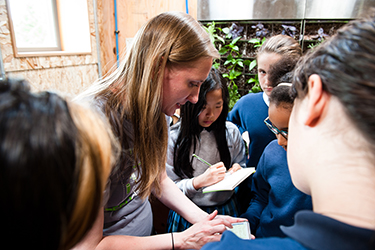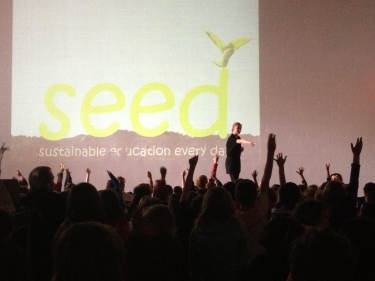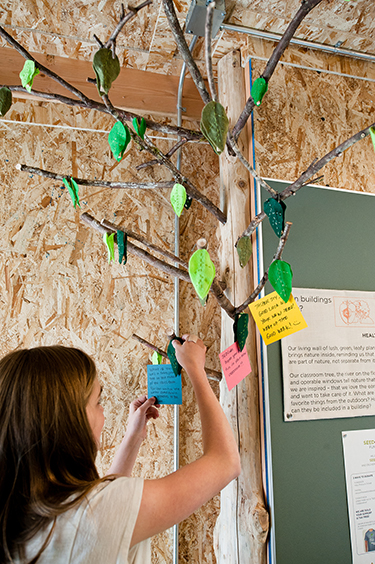|
Subscribe / Renew |
|
|
Contact Us |
|
| ► Subscribe to our Free Weekly Newsletter | |
| home | Welcome, sign in or click here to subscribe. | login |
Environment
| |
 |
September 24, 2015
How deep green buildings can educate kids
Skanska USA

Smedley
|
I have a 4-year-old son who is overflowing with curiosity and questions.
A couple of Saturdays ago, we stopped by the recently remodeled Skanska main office to play with the new shuffleboard table. But his eyes quickly went to the lights that turned on and off when we walked by, and his hands went for the removable panels in the raised floor.
He has a history of being interested in all things mechanical and functional. I remember a Sunday morning at Fred Meyer when he couldn’t have been more than 3, where he pointed to the exposed mechanical ductwork and pulled me through the store to see where it went and figure out what it was there for.
Celebrating the WHY
It’s a hunger for the why behind things that I wish more of us grownups could hold onto.
I was first exposed to this amazingly innate curiosity in children around how things work and why — specific to the built environment — through my role on the Bertschi School Living Science Building.
It was my first educational project, and it was a very deliberate and intentional move by our entire design and construction team to involve the kindergarteners through fifth grade students from the onset of the design process so they could have the opportunity to understand and impact how the building looked and functioned to meet the 20 imperatives of the Living Building Challenge.
It was an experiment that paid off as their new science building opened, with all of its sustainable systems exposed and the students’ design ideas incorporated. And our team watched as every student migrated to something with curiosity in their eyes and ownership in their excited expressions.
After the students had used the building for a while, they started telling us things like “This building is science” and “Why aren’t all buildings living?”
It was a pivotal moment for me to live through that experience with those kids. And it pushed me to dig into how our current educational system expects kids to learn and what we are testing them on, versus how kids want to learn and what we should be teaching to prepare them for what this world will be like when they are grownups. It also made me look hard at the schools and spaces we are providing for this learning, and how those spaces play into the positive or negative experience that their educational journey provides them.
Understanding the WHAT
At Skanska, we are building multiple public K-12 projects for multiple districts. Each district has its own standard in terms of systems and program, but there are two commonalities that resonate.
The first, that each district and the people that work there want what is best for their educators and their students, absolutely without question. And the second, that the funding and guidelines provided to them means that they have to many times put that first commonality aside, to simply ensure that they are able to provide space for the bodies they need to house in their schools.
The fact that funding is tight — thus “nice-to-haves” like highly sustainable systems and materials tend to get cut for the benefit of must-haves like program space — is not a new concept, nor is it specific to the educational sector. But in my mind, the educational sector is the place that suffers the most from losing those nice-to-haves, because we are dealing with the health and well-being of our kids when we look at things like materials toxicity, access to natural light and exposure to nature. Couple that with the tremendous missed opportunities on the educational side of the equation, when sustainable systems that benefit our environment are not there to explore and understand.
I feel passionately about this because I see and experience both sides of the coin. Through my social purpose corporation, SEED Collaborative (Sustainable Education Every Day), I’ve worked with multiple schools to bring SEED workshops to expose students to sustainable design and construction through the lens of the Living Building Challenge, the most stringent and holistic green building certification system.
I ask school districts to think about what a classroom could be like or feel like if its purpose was to be self-sustaining, nontoxic, beautiful, and of course teach students. Following that conversation, I ask the students to draw what they are thinking.
The results of these workshops are piles of amazing, unique and sometimes mind-blowing illustrations of the spaces these kids can dream of learning in — healthy spaces that benefit the environment, where they want to spend their days and learn things that they may not find in a textbook, such as those from the building or classroom itself.
This is the what for me. It’s the inspired looks on teachers’ faces when they see what their students can imagine and illustrate where they would want to learn if there weren’t the restrictions of budget and guidelines.
I’ve done this exercise with grownups too, and it produces the same results. Oftentimes, I couldn’t tell the difference between a 40-year-old’s drawing and an 8-year-old’s. We all want the same things with our own unique touches.
Implementing the HOW
I wish I had the golden answer to how to allow deep green buildings that teach our kids to be the standard for every public school district. But I do think that there is a path to allowing it to become at least a part of the conversation, where a building’s sustainable features that have a human health and well-being benefit, along with an educational impact, could be weighted more heavily in the guidelines that are driven from the state downward.
As more examples like Bertschi find their way into public education — through small interventions like a drawing workshop where kids imagine a sustainable classroom, or as sustainable portable classrooms like SEED or SAGE (Smart Academic Green Environment) demonstrate the impact of healthy learning spaces — I believe the proof will be in the pudding.
Teachers will find ways to teach a building’s sustainable principles as part of STEM and common core. Students will go home and tell their parents to turn off the lights to save energy. We will get there.
Stacy Smedley is a preconstruction manager and sustainable initiatives lead at Skanska USA. She previously was project manager at KMD Architects for the Living Science Building extension of the Bertschi School. She is also the co-founder of SEED Collaborative.
Other Stories:
- LID development training is a game changer here
- Survey: Shannon & Wilson
- Survey: Ridolfi
- Survey: Climate Solutions
- Survey: O’Brien & Co.
- Survey: Cascadia Consulting Group
- Survey: Golder Associates
- Here’s how to improve environmental health and safety
- New Ecology cleanup guidance: mirage or oasis?
- Kirkland taps county’s purple pipes for recycled water
- Drought heats up battle over water rights
- Designing infrastructure to combat climate change
- Building green? Don’t forget green financing
- Survey: Innovex Environmental Management





